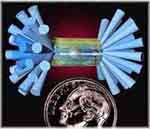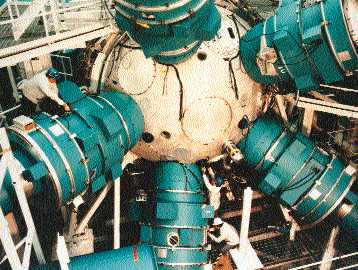Main Page
Inertial Confinement
Another method for the confinement of fusion is the Inertial Confinement Method.
It is named this because the length of the reaction is determined by the inertia
of the fuel itself. In this method, laser or particle beams are aimed at a small
capsule of fuel.

The high temperatures of the beams evaporate and vaporize the
outer layer of the material, leading to the creation of a plasma crown. As this
expands, it generates compression (up to 1000 times the material's density) that
heats the inside of the capsule. When the internal temperature reaches one
hundred million degrees, the fuel ignites and fusion occurs. The reaction then
spreads through the compressed capsule, producing energy several times greater
than what was deposited by the beams.

The majority of research so far involving this type of fusion has dealt with
laser beams. These powerful flashes of light, with varied wavelengths and duration,
are focused on the capsule to initiate fusion. However, our modern lasers are
very inefficient. To be used in a commercial fusion plant, laser technology
would first have to greatly improve.
Another option in Inertial Confinement is ion beams instead of lasers. The ion
beams are much more efficient, but are still very experimental. The biggest
problem is the beam's short span. An intense enough beam to cause the reaction
only lasts about 10 nanoseconds. To compensate, scientists must compress the
beam and make it stronger.
Main Page


